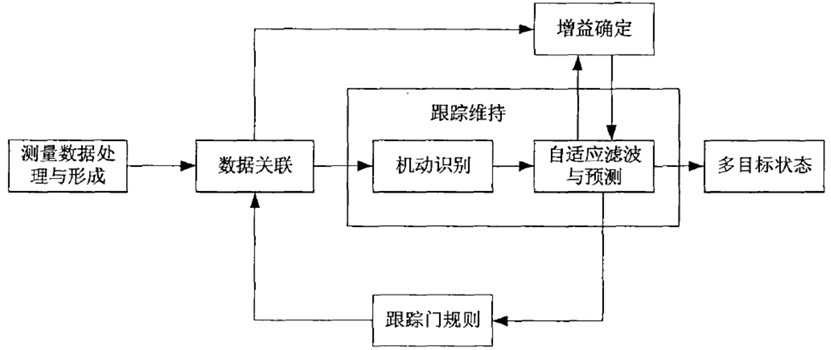The principle and elements of multi-target tracking radar

The principle of multi-target tracking radar can refer to the following figure. The process of adaptive filtering and gain determination is the same as that of single target tracking. The overall process is a recursive process. At each moment, the radar receives target echoes and associates them with previously determined target trajectories. Target echoes that do not enter the tracking gate are considered as echoes of new targets, and a new trajectory is established for data correlation at the next moment. At this moment, the target trajectory is adaptively filtered to predict the position of the target at the next moment, and the target echo is filtered and output. Determine the target change gain during the data association update and filtering process. When the trajectory is not updated by the new target echo, the predicted value is used to update it. When it has not been updated for a long time, it is considered that the target of the trajectory has exceeded the field of view, and the trajectory is invalidated.

Therefore, the basic principles of multi-target tracking radar include tracking gate control, trajectory initiation, data association, trajectory cancellation, etc.
1. Tracking wave gate mechanism
It refers to the determination of the tracking range for each trajectory division in the process of multi-target tracking. The tracking gate can change at any time, and its center position is always at the predicted position of the tracked target at the previous time.
The main purpose of tracking the wave gate mechanism is to:
1) Confirm with new data: When the observed target echo is identified as an echo of a certain trajectory based on the tracking wave gate mechanism, update the trajectory data using this newly observed target echo. But generally, there may be multiple echoes falling within the tracking gate range of a track at the same time, so all candidate echoes within the tracking gate may be real target echoes and used to update the target’s state. The specific echo used is related to the use of algorithms such as “nearest neighbor” and “all neighbor”.
2) Establishing a new temporary trajectory: When the observed echoes at a certain moment cannot be correlated with any previously established trajectory, these echoes may be the echoes of newly appearing targets within the radar observation range or false alarms caused by other reasons. These new echoes can be used to establish a new temporary trajectory. If the target echo cannot form a stable target trajectory within a certain observation time, it is considered a false alarm by the temporary aviation exchange and the trajectory is revoked.
2. Track correlation
The trajectory correlation process is the process of associating all echoes received at this moment with all known trajectories to determine which target trajectory multiple echoes belong to. The trajectory correlation process is another core part of multi-target tracking.
Rough joint can be achieved through tracking the wave gate mechanism. However, in an environment with multiple target echoes, especially when the trajectories of two targets are close or overlapping, it is difficult to distinguish the target echoes and determine which target trajectory the echoes belong to. At this point, multiple target echoes may be located within the same track tracking gate, or only a single target echo may be drawn into multiple tracking gates. The nearest neighbor method is simple to calculate and easy to implement through programming. But in environments with dense targets or clutter interference, the usage effect is not very good. For targets with similar or intersecting trajectories, the echo with the smallest statistical distance from the trajectory may not necessarily be the echo of the target trajectory. Therefore, this method is likely to result in tracking errors or loss of targets in practical use.
3. Track initiation and cancellation
Track initiation is the process of initializing the track. Generally, the remaining target echoes after the above target correlation cannot be correlated with known target trajectories. They need to be correlated with each other and determined as the initial position of the new target trajectory, which is considered a temporary trajectory. Once a new temporary trajectory is formed, certain rules need to be used to confirm that it is a target rather than a false alarm. The commonly used methods include determining the start of the trajectory when M correlations can be performed in N scans (M<N), and decision-making methods based on posterior probability.
Track cancellation is a decision-making method for clearing redundant or false target tracks. When the tracked target escapes from the tracking range or is determined to be a false alarm target, the target echo update cannot be recorded at any time. To avoid redundancy in storage and calculation, the tracking system must make a decision to cancel the trajectory. Similar to the method of trajectory initiation, commonly used methods include the method of determining trajectory initiation when M<N correlations can be performed in N scans, and the decision method based on posterior probability.
